ONCE upon a time, the River Thames was a working river. The docks thrived. The Ports of London was a hive of imports, business and skullduggery. No part of London has changed more than the docks. In the late 1930s, London Docks was the busiest port in the world. Forty years late, the docks were a grim hangover from a greater age. In the 1980s and 90s, the area underwent a huge transformation. Once unloved streets are now remarkable for how hard it is to book a table for lunch.
We’ve trawled the archives to bring you this story of the River Thames in London before 2000.
The Tram
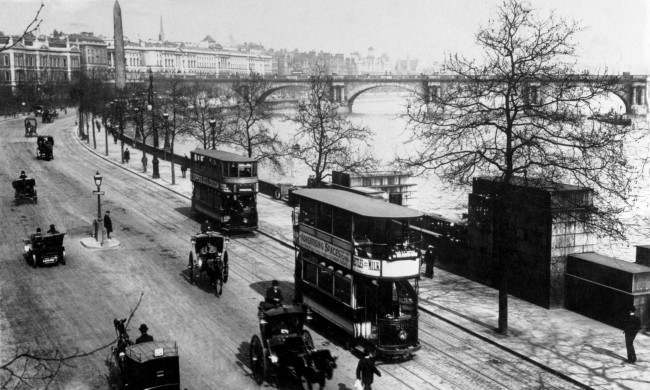
Trams running along the Victoria Embankment. The ancient Egyptian stele taken from Egypt and known as Cleopatra’s Needle can be seen in the background. Date: 01/02/1904
Tower Bridge – London

A view of Tower Bridge on the River Thames in London, when the river froze over in December of 1895. Date: 31/12/1895
Deadman’s Dock – Deptford Wharf (1911)
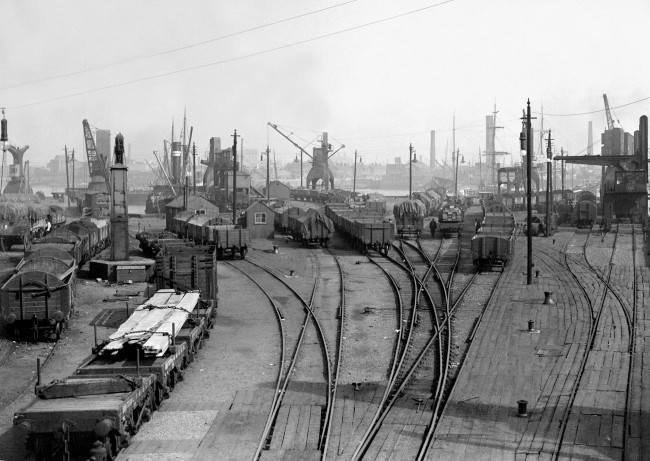
Deadman’s Dock, or Dodman’s Dock, was named after the shipbuilders Dudman & Company, who operated here at the end of the 18th century. It was bought from them by the Brighton and South Coast Railway Company in 1850. It was then owned by Southern Railway and eventually British Rail after nationalisation, until it closed in 1970. It is now the site of the Surrey Quays shopping centre on the Isle of Dogs.
Unloading tobacco at the Royal Victoria Docks
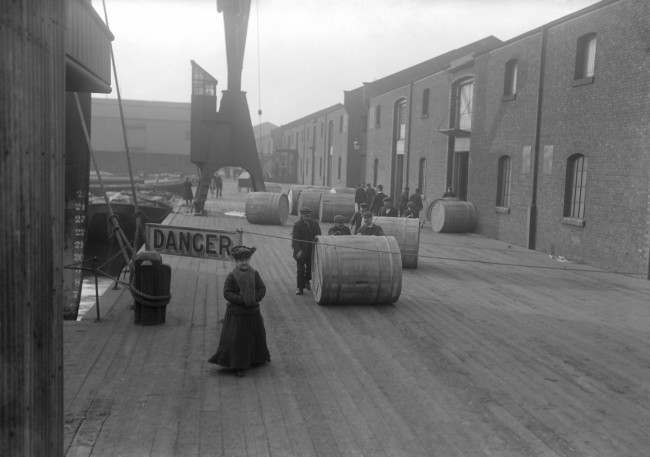
Hemp
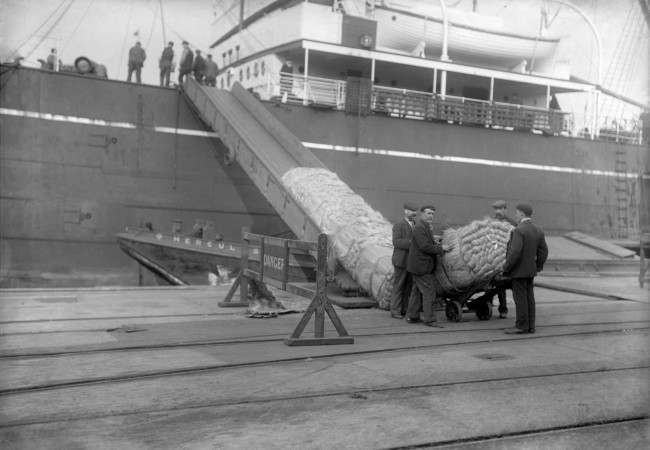
Opened in 1855 on a previously uninhabited area of the Plaistow Marshes, it was the first of the Royal Docks and the first London dock to be designed specifically to accommodate large steam ships.
Tower Bridge – London
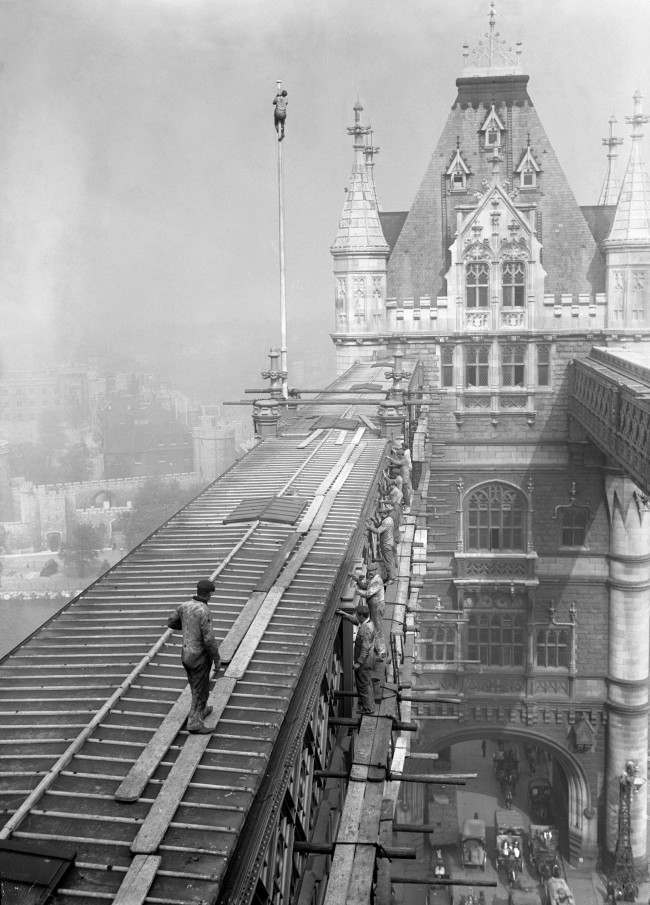
A workman on one of the gantry ways high above Tower Bridge, London. Date: 01/01/1913
The Ivory Floor
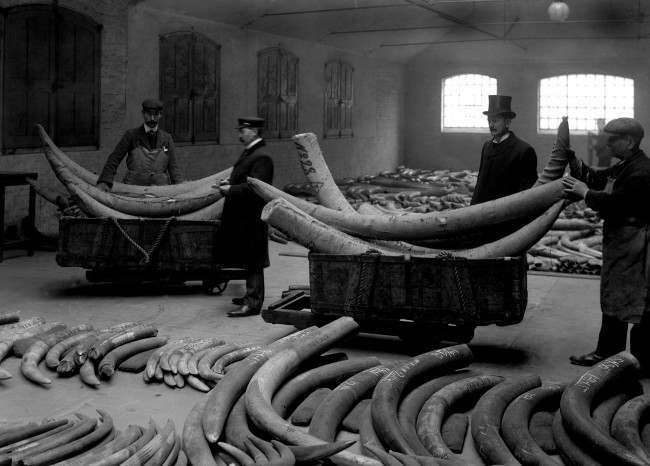
A view of the “Ivory Floor” where elephant tusks, boar tusks, narwhale horns, rhinocerous horns and sometimes mammoth tusks are ranged in incredible profusion. It is said than many, perhaps most of the tusks of elephants displayed are not of freshly killed beasts, but are old treasures of Chiefs, reluctantly surrendered, stored maybe, for centuries in remote African Villages. The picture shows men moving some of the large tusks on specially constructed trolleys. Date: 01/01/1913
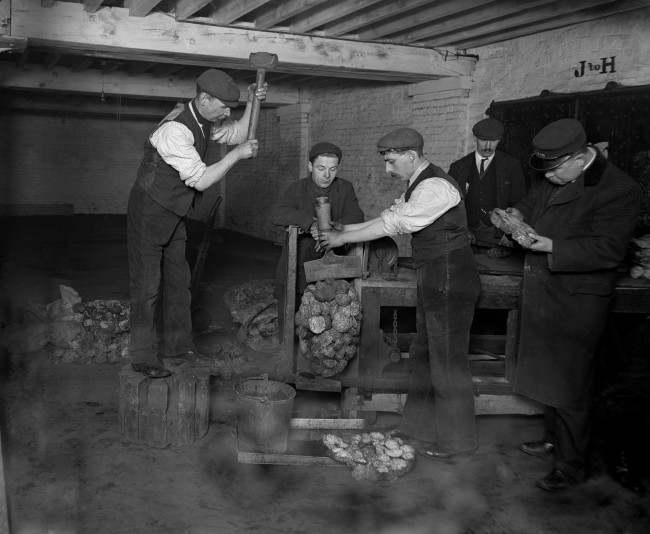
Raw rubber being prepared for sale.
Floods – London – 1928

A rowing boat washed up from the Thames in to Page Street, Westminster, London. On January 6, 1928 the flood tide in central London was 1.8m above predicted level. Fourteen people drowned in their basements. Four thousand were made homeless.
Thames Police headquarters at Wapping.
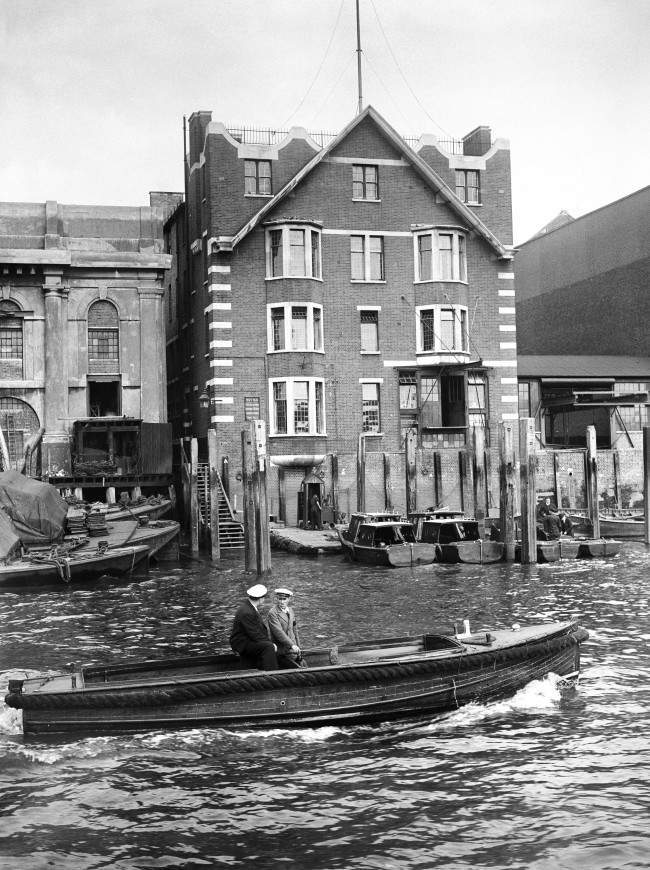
The Thames Police originated in 1798 and was the first force of it’s kind ever set up and was to act as the blueprint for many of the police forces that were to follow it. The force was absorbed into the Metropolitan Force in 1839 and was renamed ‘The Thames Division’, but to most people on and off the river it is still just ‘The Thames Police’. Date: 07/09/1934
Children at Play – London – 1935
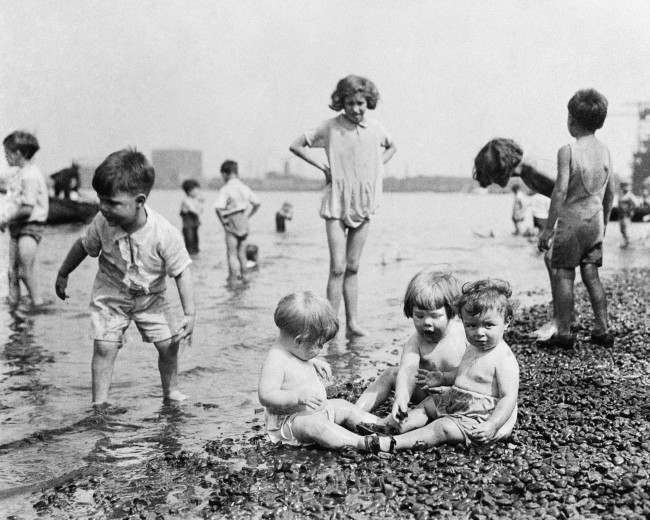
Children playing at Greenwich Riverside. Date: 26/09/1935
Free and easy
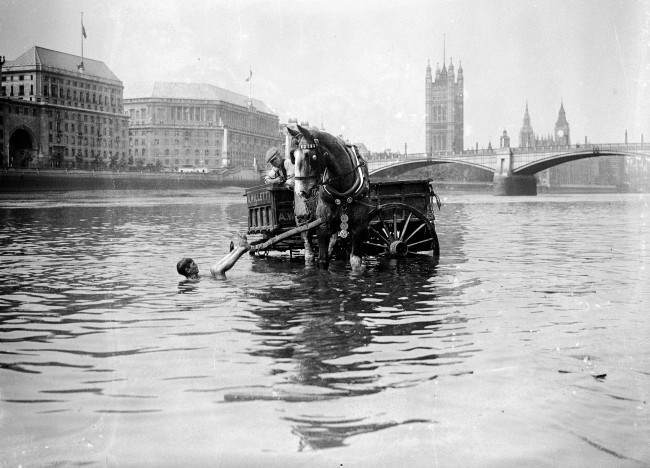
A horse and along with it’s carriage take a dip in the Thames, Vauxhall to cool off in the summer heat. Date: 22/08/1935
London Mackenzie King
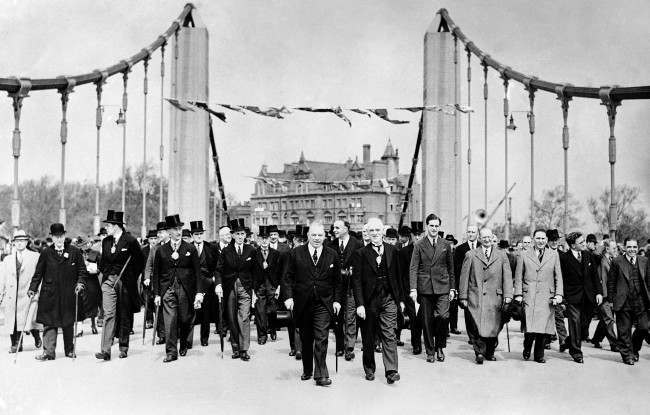
W.L. Mackenzie King, Prime Minister of Canada, left, leads the public over the new steel suspension bridge over the River Thames at Chelsea, London, May 6, 1937, which he opened when he cut the tape.
Leslie Burgin Inspecting Tunnel
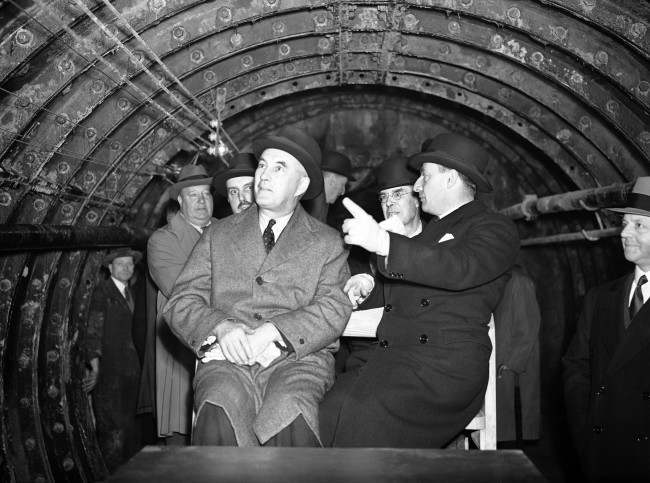
Leslie Burgin, Minister of Transport, inspected the Dartford-Purfleet pilot tunnel, England on Nov. 28, 1938. This pilot, which is nearing completion is 12 feet in diameter, passes under the bed of the River Thames, at a depth of 92.5 feet and has a total length of approximately 3,300 feet. It is the pilot to the construction of the larger tunnel, and when completed there was an error of only 3/8 of an inch in line and 3/16 this in level. The full size tunnel will be 28 feet in diameter, with a carriageway and two narrow patrol footpaths and will be approximately a mile in length from portal to portal. Leslie Burgin, right, coming through the tunnel on a light railway. Date: 28/11/1938
Working ports
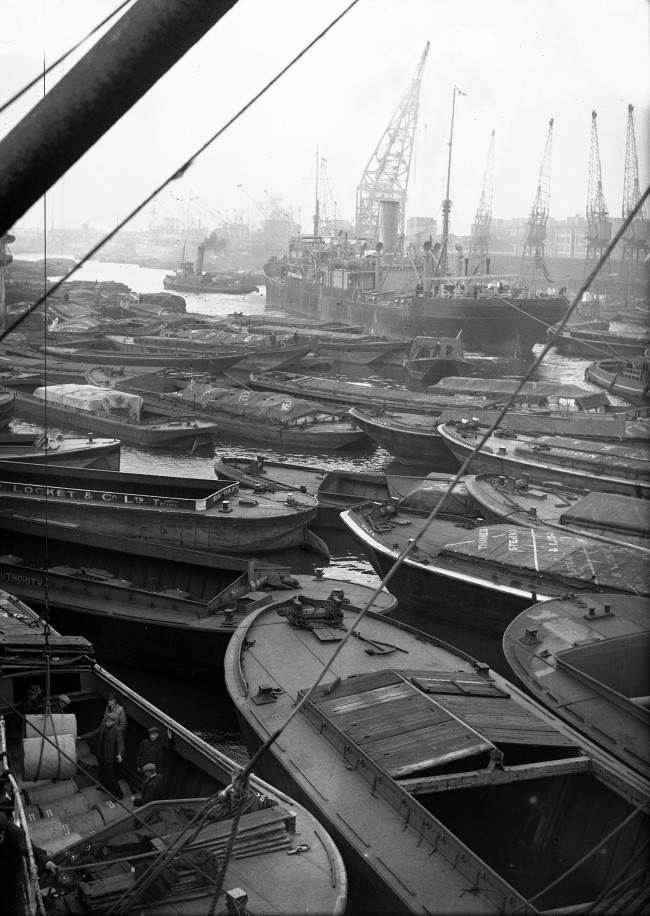
Wartime goods and supplies are unloaded from barges and boats in the London docks, on the River Thames, Nov. 9, 1939.
WWII Europe British Isles People Transportation

Londoners went to work by boat instead of usual bus or train, for a Thames boat in service between Westminster an wool with was inaugurate at 6.30 a.m. A Thames steamer, with Londoners on board going to work, off on a trip from Westminster in London on Sept. 3, 1940.
WWII London Blitz
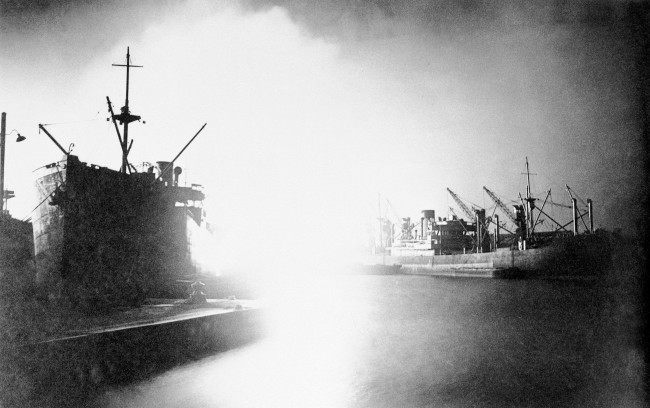
Thames as seen the night of Sept.7, 1940 during the biggest raid of the war on London. The shipping was illuminated as the river reflected the flames from fires started in the industrial districts of the east end.
WWII British Isles
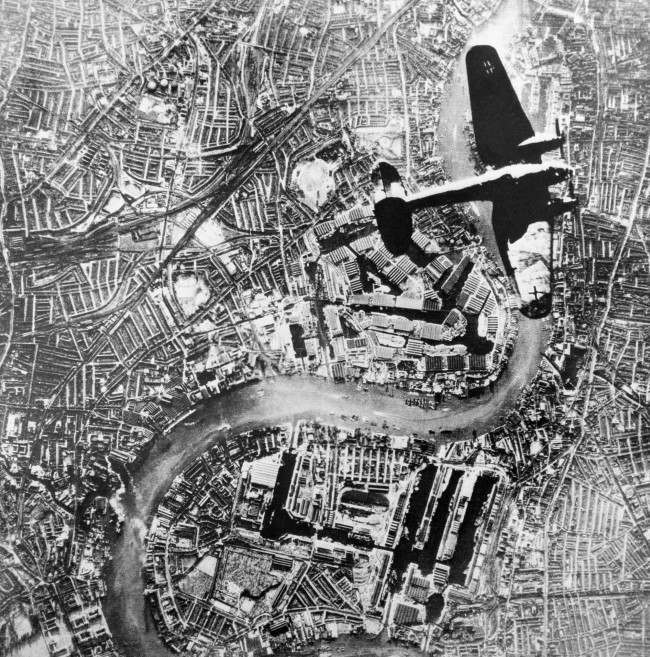
A Nazi Neinkel III wings over London during battle of Britain in autumn of 1940, in German aerial view now in hands of RRF, Sept. 13, 1945. Tower Bridge over Thames is at top, slightly to the right of the plane’s left wingtip.
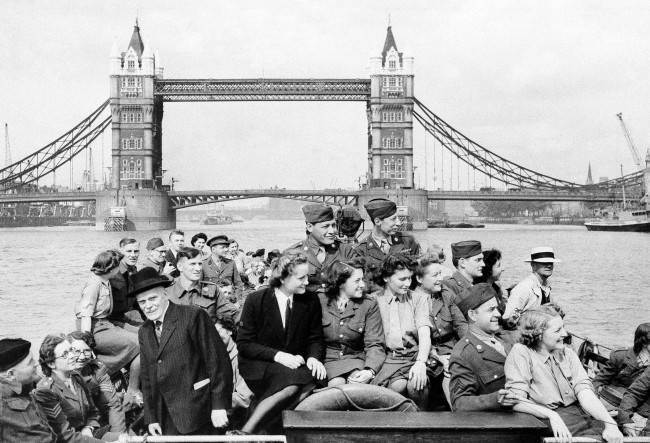
With Tower in Bridge in the background, members of the allied forces who are taking courses at London University steam up the Thames in London, August 25, 1943. British Empire and American services are all represented in this happy boatload of sightseers, all of whom are enrolled in Weekend courses in various subjects, including current social and economic problems in the United Kingdom. Among them are Sgt. Calexto Mora, of Falfurrias, Texas; Sgt. Frank A. Lambright, Akron, O.; Sgt. William A. Hassett, Staunton, Va.; Yala Jacobson, American Red Cross of Washington and Cpl. Edward Kowersli, Chicago, Ill.
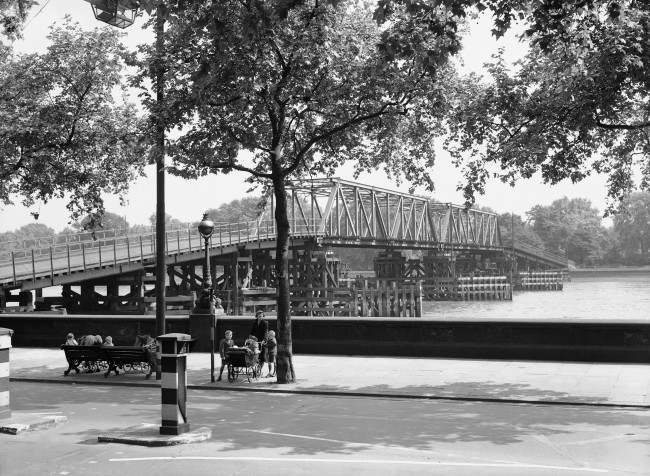
This temporary bridge at Battersea, June 11, 1945, was one of three constructed over the Thames in London, capable of carrying tanks, guns, and heavy motor traffic if the permanent bridges were bombed. When the Hungerford Bridge at Westminster was hit by a buzz bomb in 1944 the substitute was opened for pedestrian traffic.
Moving of War Bridge – London
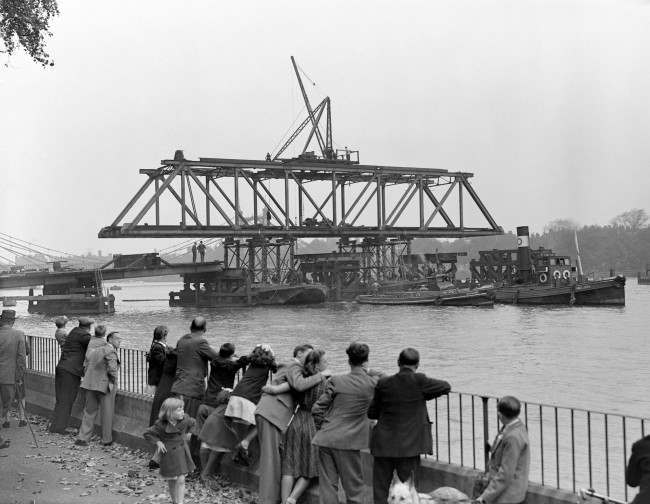
The main navigational span, which was removed from the war-time bridge between Chelsea bridge and Albert bridge, is seen being maneuvered on the river Thames. The bridge is to be re-erected in Uganda for use in connection with the groundnut scheme. Date: 03/10/1948
Bankside Power Station – London – 1947
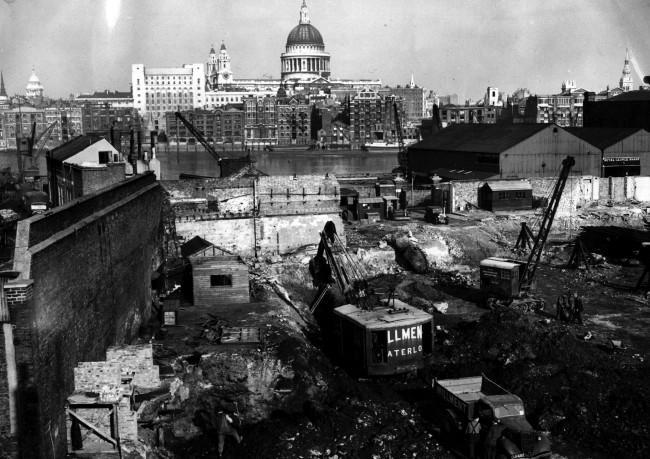
The first stage of the preparations for the erection of the new Bankside Generating station, across the River Thames from St.Pauls Cathedral, in Southwark. Date: 05/11/1947
Historical Re-Enactment – The Vikings – London
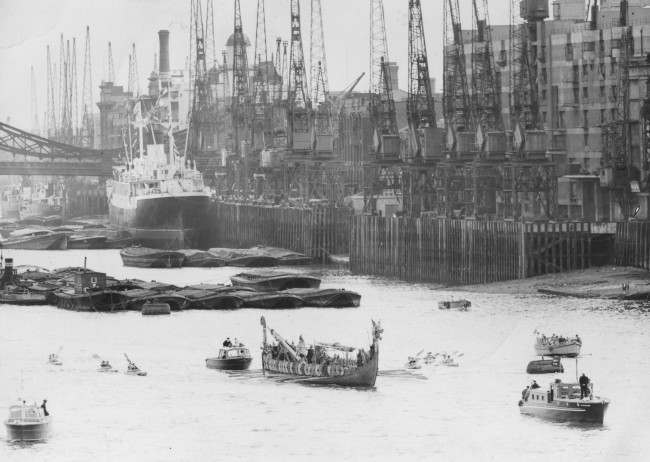
The cranes of London’s waterfront above Tower Bridge make a 1949 setting for the Viking long-ship ‘Hugin’, as it’s crew of Viking warriors row from Tower Pier to Richmond in Surrey.
It is taking part in number of events to commemorate the landing of the Norse leaders Hengist and Horsa at Broadstairs on the Kent coast 1500 years ago. Date: 01/08/1949
Short Solent Flying Boat – London – 1949
A BOAC Short Solent flying boat moored off the Tower of London. Date: 05/05/1949
Doggett’s Coat and Badge – London
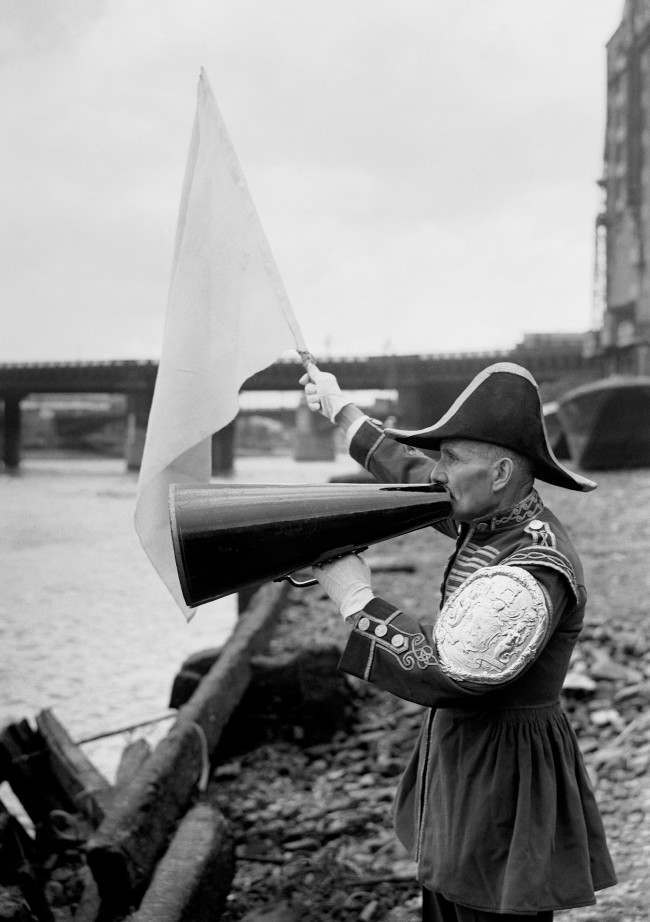
Wearing his picturesque uniform as Bargemaster to the Fishmongers Company and assisted by a megaphone, Mr Harry Phelps starts the 235th race of the Thames Watermen for Doggett’s Coat and badge at London Bridge. Doggett’s Coat and Badge is the prize and name for the oldest rowing race in the world, and is believed to be the oldest sporting contest in continued existence. Date: 29/07/1949
Shipping – 1949
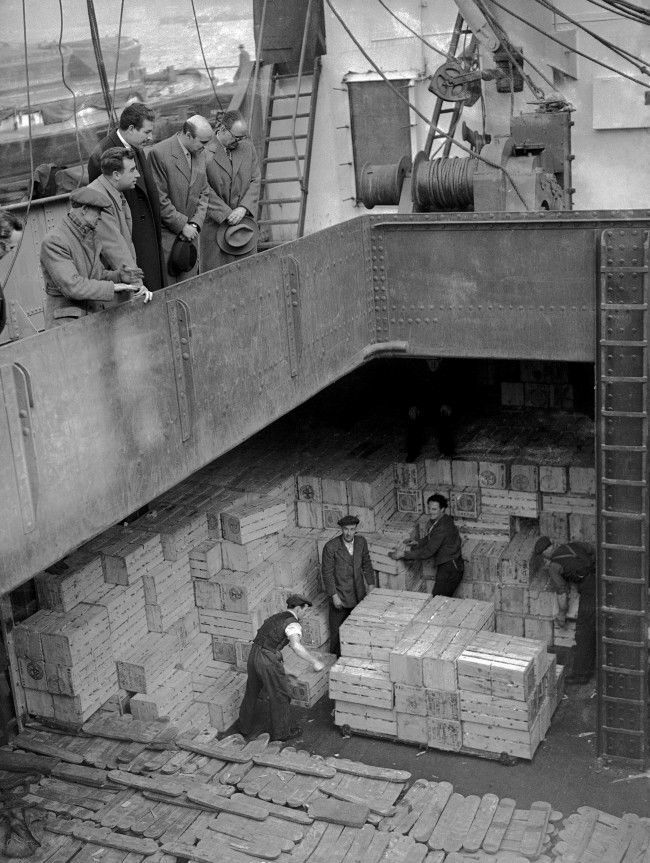
Lemons being unloaded from a ship in dock.
Animal Containers destined for Zoo arrives, Royal Albert Docks 1950
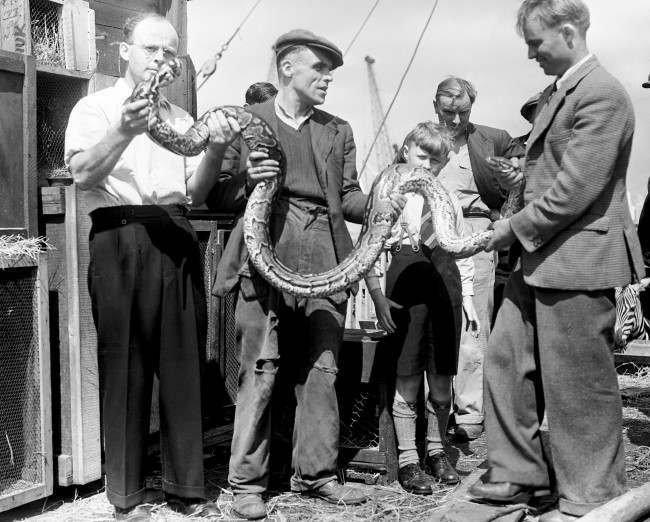
Animal containers destined for London Zoo arrive at the Royal Albert Docks and workmen carefully carry a python as a young boy looks on. Date: 05/08/1950
Clement Attlee speaks at Concert Hall ceremony
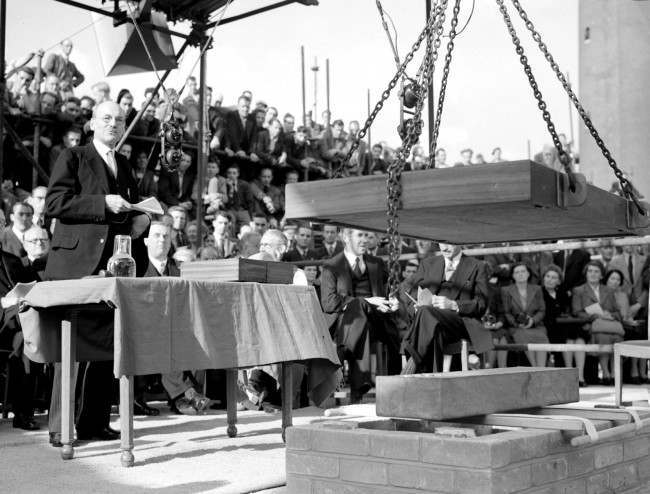
Mr Clement Attlee, laying the foundation stone of a 2m Concert Hall being erected by London County Council on the South Bank of the Thames. Date: 12/10/1949
Port of London – 1950
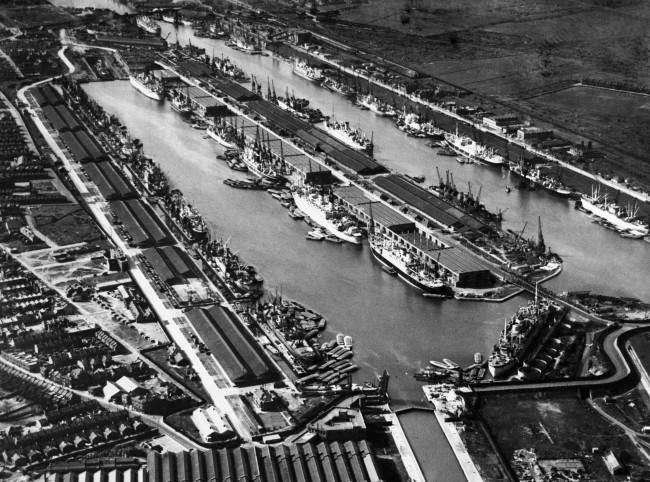
An aerial view of the Port of London.
Punch & Judy Shows – London – 1950
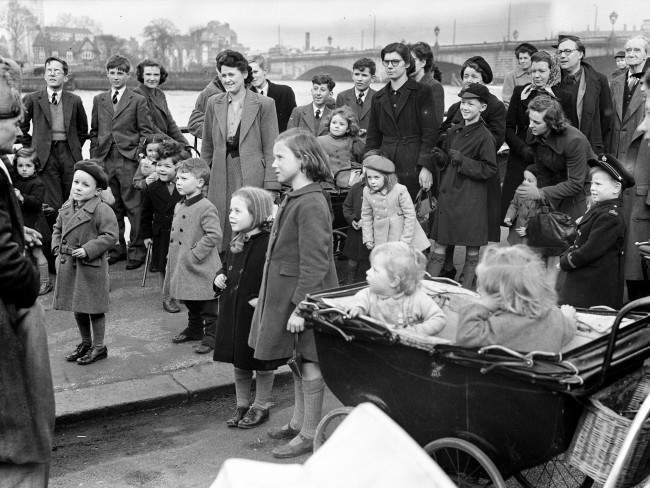
Mother’s and children watch a Punch & Judy show at Putney on the Thames tow-path. Date: 21/03/1950
The Festival of Britain – London – 1951
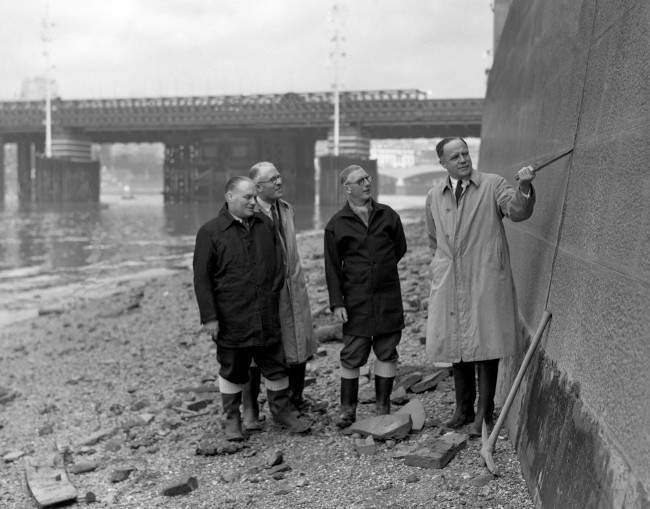
London County Council officials inspect the Festival of Britain South Bank wall. Left to right: E Bayliss (Chairman, General Purposes Committee); F M Fuller (LCC Divisional Engineer); I J Hayward (Leader of the LCC) and J Rawlinson (LCC Chief Architect). Date: 11/04/1951
South Bank
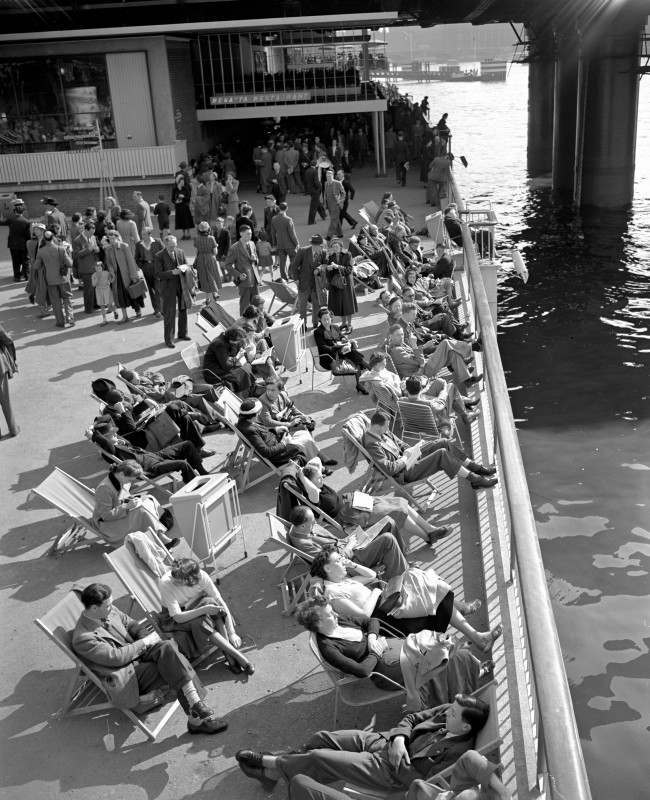
People lazy in the midday sun at London’s South Bank. Date: 12/05/1951
London Scenes 1951
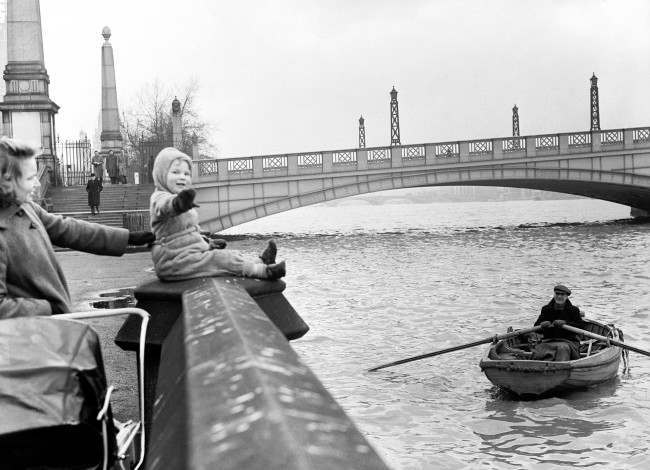
A little girl sits on Embankment Wall at Lambeth Bridge and looks at the River Thames. Date: 20/02/1951
The Festival of Britain – London – 1951
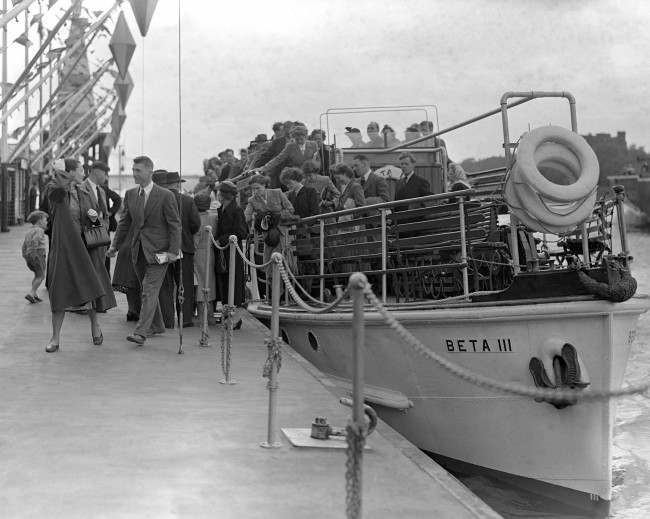
A view of the Festival of Britain, showing the Dome of Discovery, Skylon tower and Royal Festival Hall. Date: 01/06/1951
Dock Strikes – London
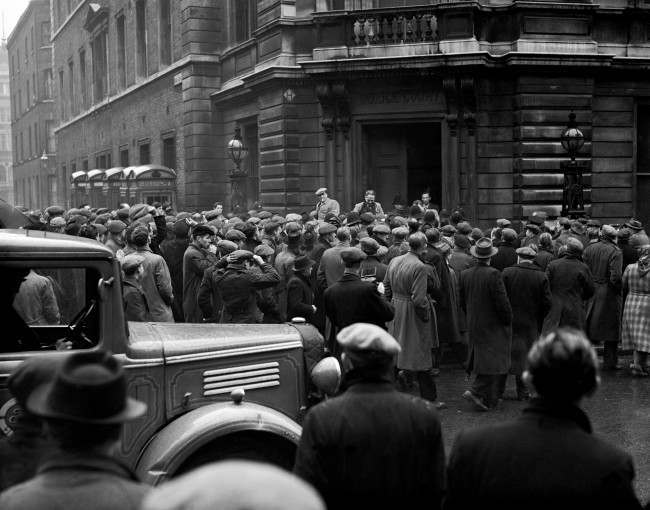
The scene as dockers were cheered by their comrades after they had been remanded, on bail of £100 each, at Bow Street Magistrates Court, London. The six men were arrested last night and charged on warrants with conspiring to incite dockers to take part in an illegal strike Date: 09/02/1951
The Festival of Britain – London – 1951
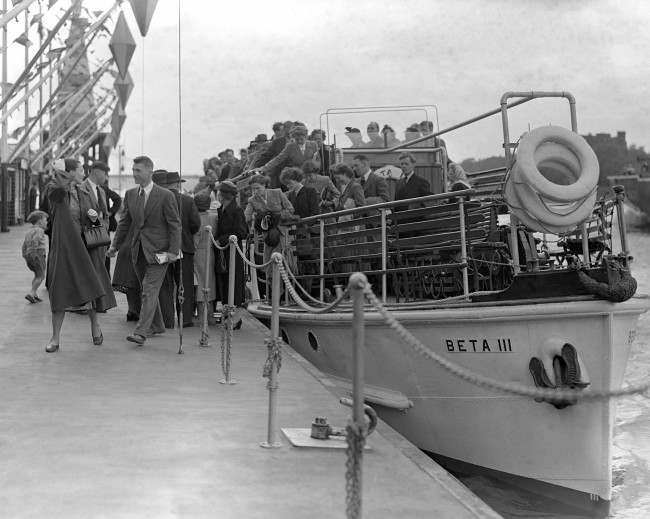
Thames Water Bus Service – Passengers disembark from a water bus at the landing stage for the festival in Battersea Park. Date: 07/06/1951
The Festival of Britain – London – 1951
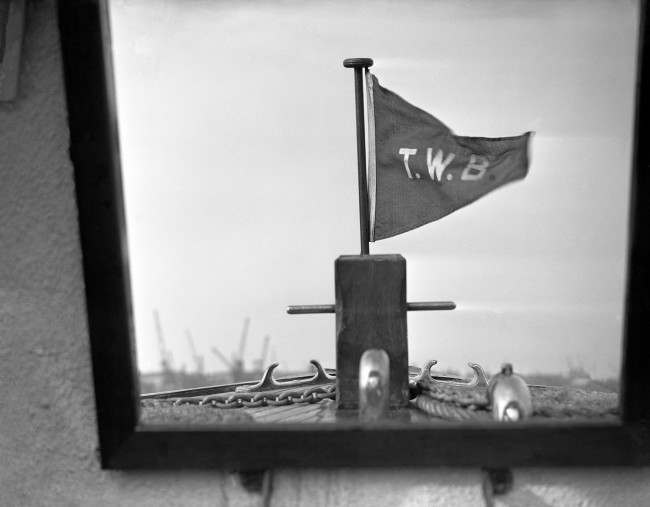
Thames Water Bus Service – A TWB flag. Date: 27/06/1951
Death of King George VI – London
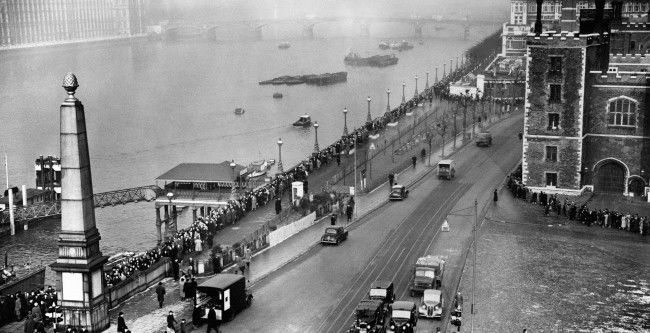
Thousands of people slowly move along the south bank of the Thames opposite the Houses of Parliament to pay tribute to King George VI at his lying in state in Westminster Hall. Date: 13/02/1952
Water Walker of the World – London
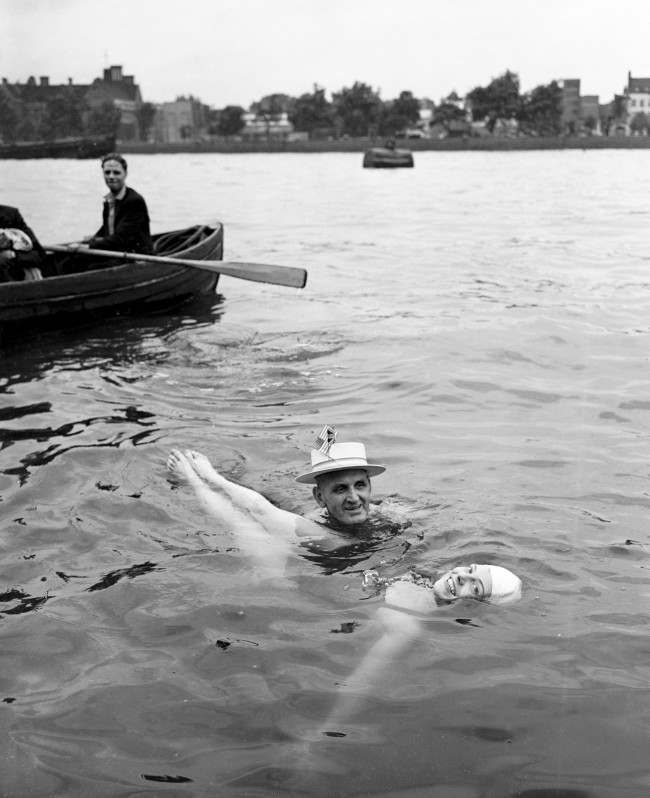
1947 and 1948 Champion Water Walker of the World Joe Simms carries dancer Margaret Cooper across the River Thames, London. His system of water locomotion is called ‘hydro-ambulation’. He stands erect and moves his legs with a slow cycle action. Date: 09/07/1951
Royal Navy – Midget Submarine – London Pool

The midget submarine XE8 arriving at the Pool of London. Date: 01/10/1952
BRITAIN FLOODS 1953

HMS Berkeley Castle, a Castle class frigate, lies on her side in a refitting basin at Sheerness, Kent, Feb. 1, 1953, after being capsized by high winds and rampaging seas. Sheerness, on the south bank of the Thames Estuary, 30 miles from London, was hit by bad weather which flooded Britain’s east coast last night.
Tower Beach – Tower of London

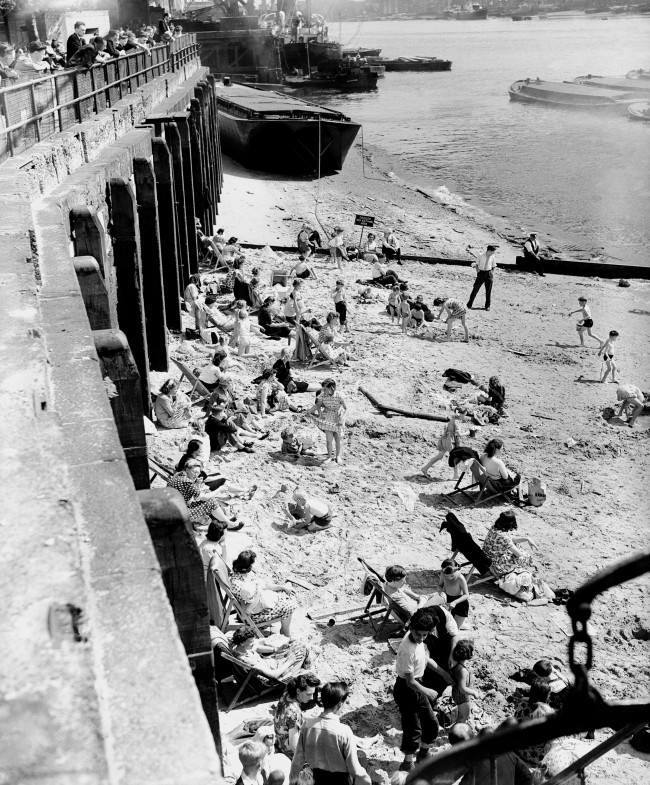
Children enjoy the summer in the centre of London, paddling in the River Thames on a man made beach with Tower Bridge in the background. Date: 11/08/1953
Tower Beach – Tower of London
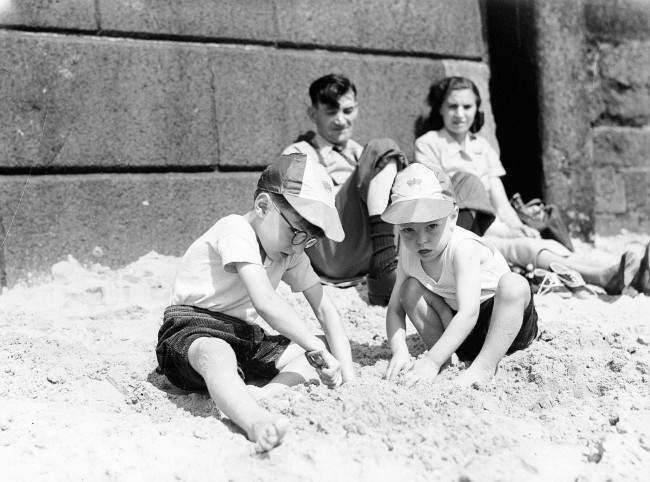
Children enjoy the summer in the centre of London on Tower beach, a man made beach on the banks of the Thames near Tower Bridge. Date: 11/08/1953
Victoria Embankment – 1954
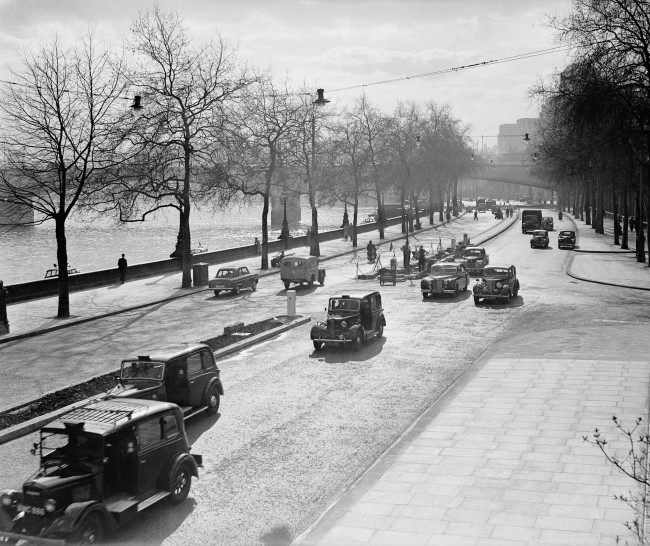
Victoria Embankment, London, after the construction of the roadway. Date: 01/04/1954
Royalty – 1954 Royal Tour of the Commonwealth – London
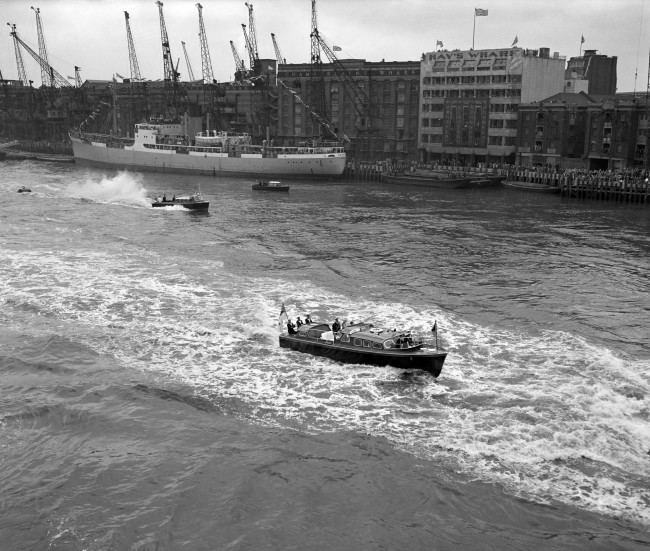
The Royal Barge on the River Thames bringing Queen Elizabeth II from the Royal Yacht Britannia, after returning from a tour of the Commonwealth. Date: 15/05/1954
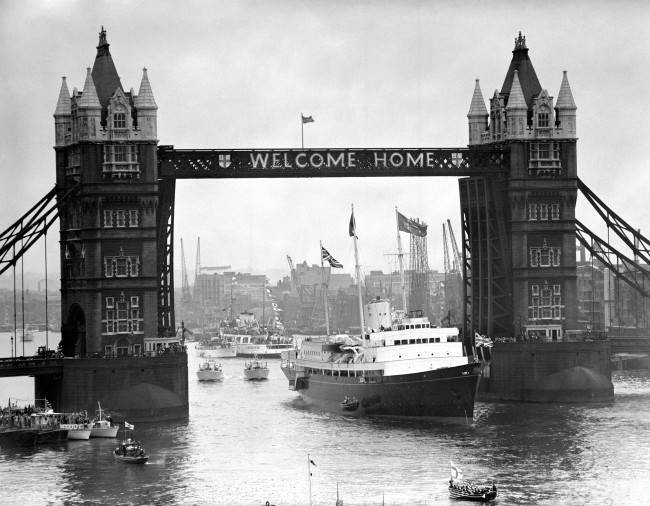
The Royal Yacht Britannia passes through Tower Bridge, wearing a ‘Welcome Home’ sign, as she entered the Pool of London at the end of a 50,000 mile journey for the Queen and Duke of Edinburgh, whom she had brought home from the tour of the Commonwealth.
Entertainment – High-Wire Motorcycle Act – London – 1954
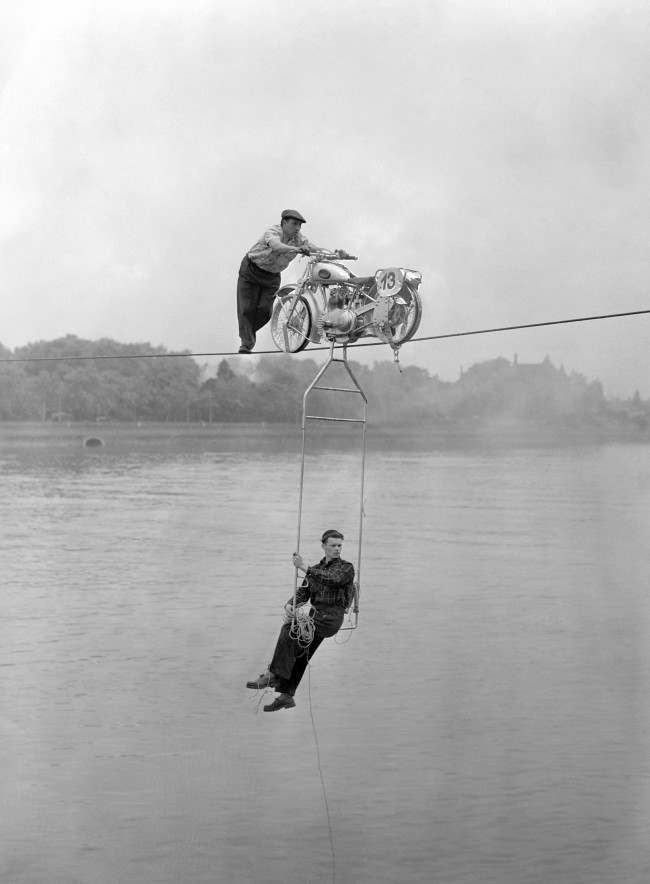
The “Bugler Brothers”, Alphonse (top) and Charles (below) when the motor-cycle of their high-wire act broke down during a crossing of the Thames at Battersea. Date: 31/05/1954
Schoolchildren on a passenger barge during a tour of the docks
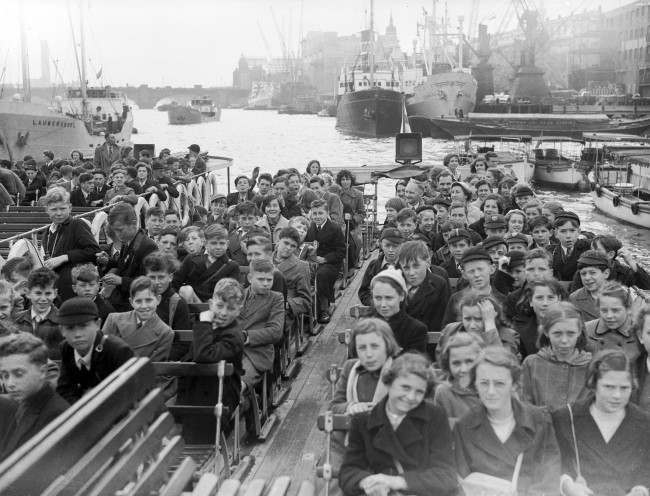
Date: 10/06/1955
St Paul’s Cathedral – 1955
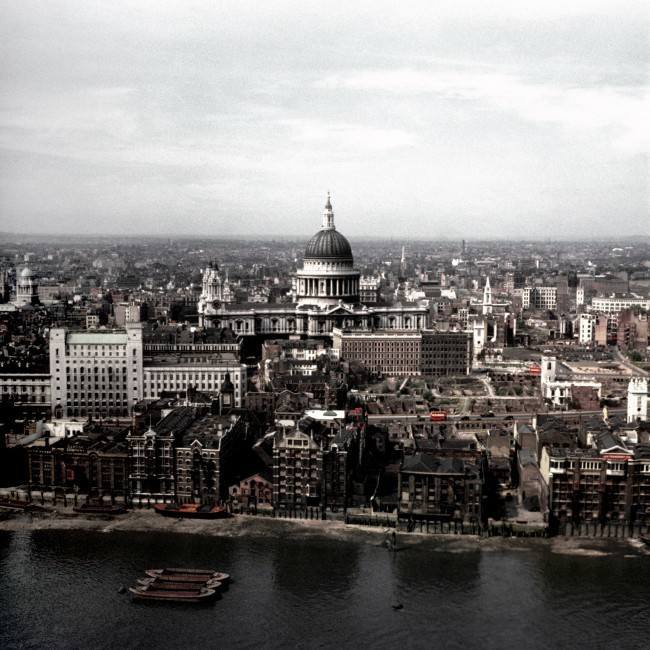
The River Thames and St Paul’s Cathedral from Bankside Power Station.
Westminster Pier – London
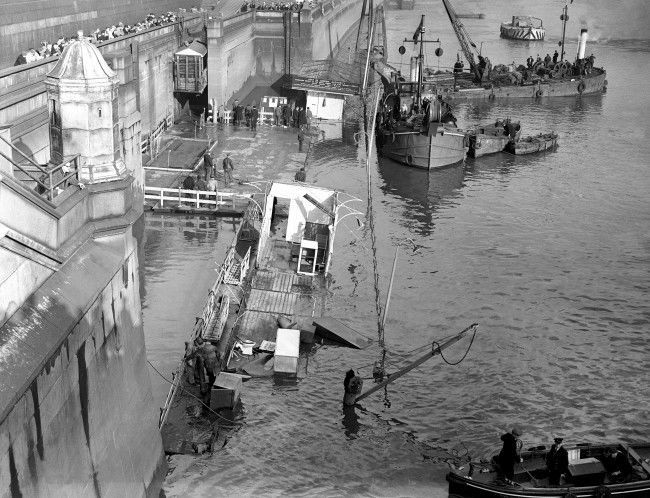
Heavy lifting gear and cranes try to raise the sunken Westminster pier. Date: 08/02/1955
Tower Bridge – 1955
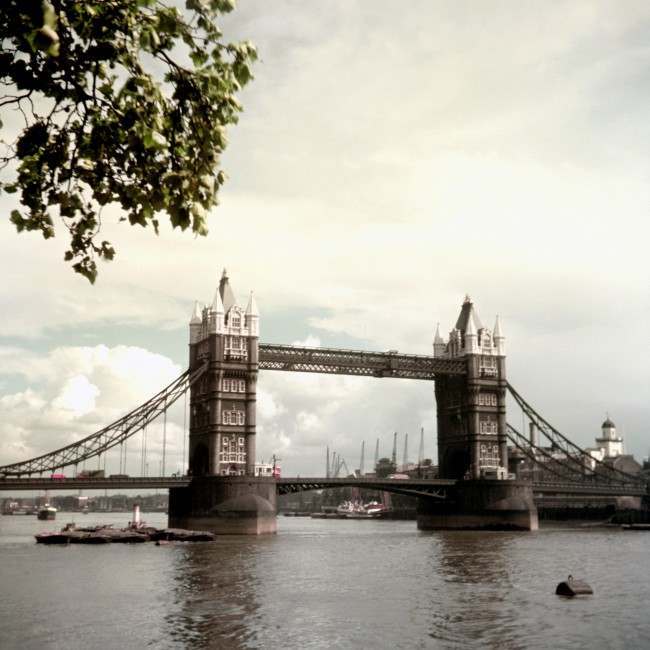
Tower bridge, a combined bascule and suspension bridge over the River Thames in London.
Royal Navy HMS Apollo – Port of London
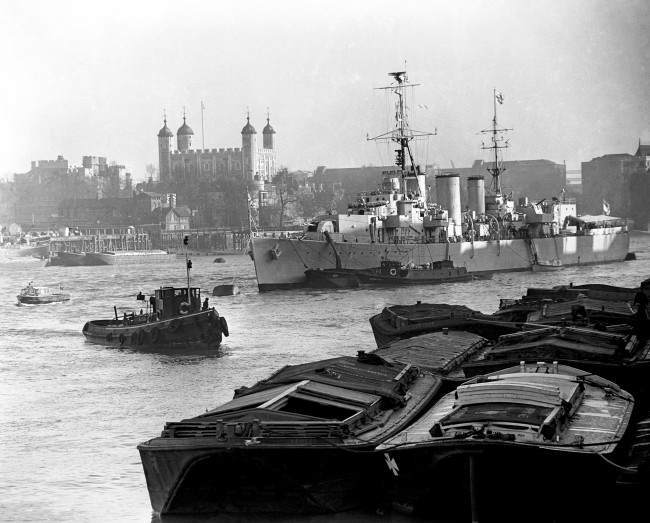
Minelayer HMS Apollo in the port of London with a tug beside her. Date: 03/12/1954
Sunflower Grows on the Thames
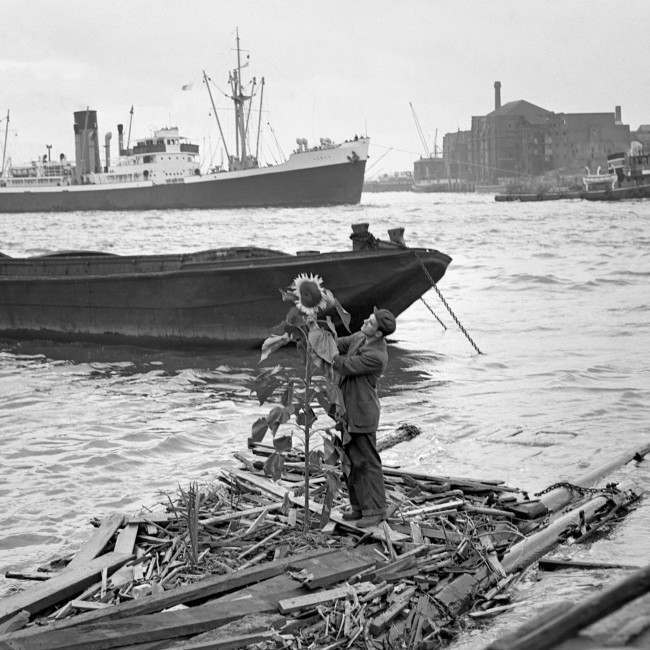
A seven foot sunflower with a nine inch span grows on a narrow raft in the Thames at Limehouse, East London. With the flower is Mr F Conn, who lives in Limehouse. The flower is believed to have grown from a seed dropped from a bird. Picture date: 16th Sept 1955.
Mines
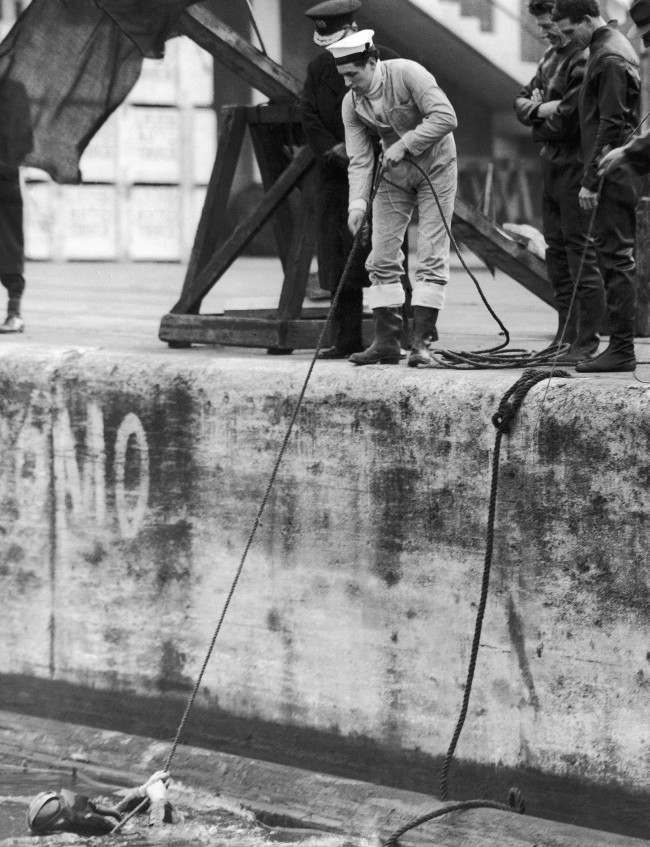
A Sailor Hauls on a rope as Lt. Commander G. Gutteridge breaks the service of the Muddy water of the West India Dock, London, Jan. 26, 1957 after inspecting a six-feet long parachute mine discovered there by divers. Bomb disposal experts plan to tow the mine down the Thames for detonation. Date: 26/01/1957
Car Park – 1963
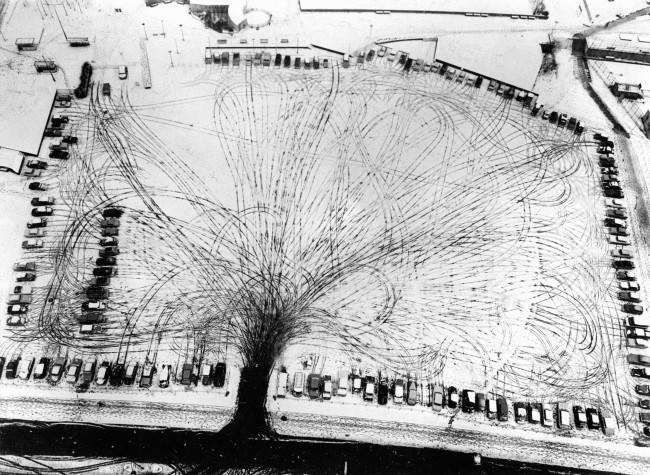
The view looking down onto a car park, taken from the 26th story of the great Shell Centre on the south bank of the river Thames in London. The “tree” effect is formed by the wheels of the cars as they enter and leave the park. Date: 02/01/1963
Politics – State Funeral of Sir Winston Churchill – Tower Pier – London – 1965
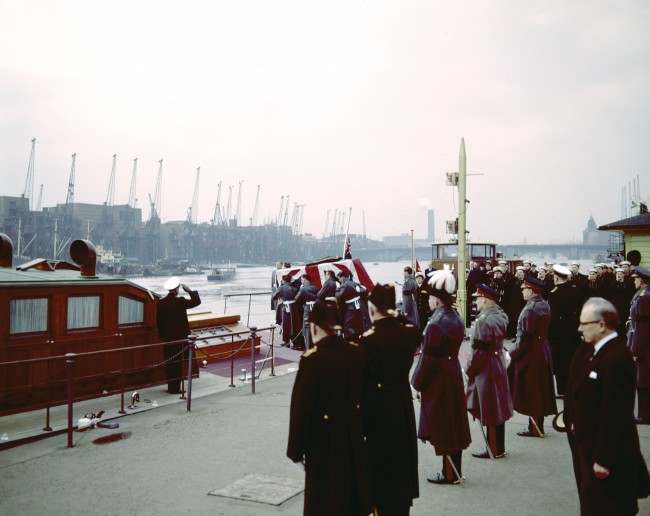
Sir Winston Churchill’s coffin is carried aboard the Havengore, a ceremonial launch at Tower Pier in London. Date: 30/01/1965
Battersea Power Station – London
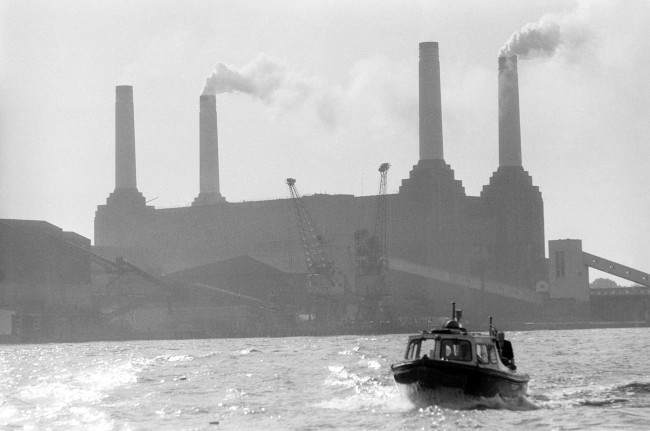
A view of Battersea Power Station from the river Thames. Date: 06/10/1971
Warehouse Fire – Wapping – 1973
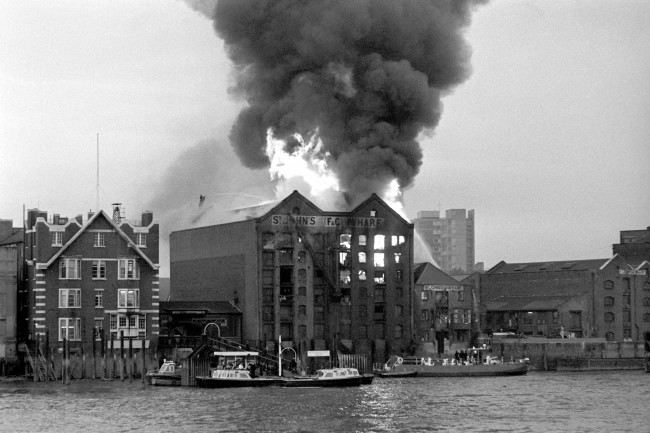
A seven storey warehouse on fire at the Metropolitan Wharf, Wapping, east London. More than 100 firemen and 40 appliances fought the blaze. Date: 05/10/1973
PC makes a splash

As the Thames overflows its banks at Putney, a mounted policeman, PC Rushmer, rides on his horse Redwing through the flood, looking for people caught unawares. An exceptional tide – over 25 feet at London Bridge – had been predicted, and was further swollen by heavy rain upstream. Date: 30/01/1975
Flooding in London
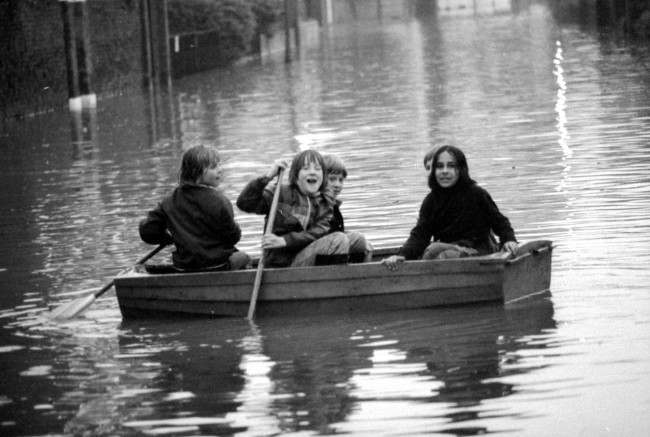
The Thames overflows its banks at Putney. An exceptional tide – over 25 feet at London Bridge – had been predicted, and was further swollen by heavy rain upstream. Date: 30/01/1975
Tower Bridge – London
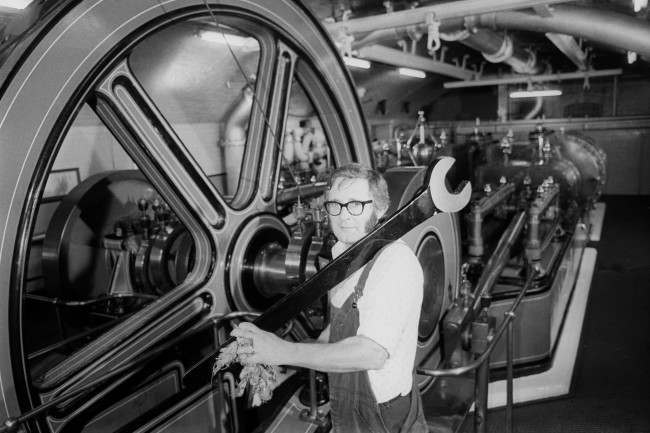
Bridge foreman Stan Fletcher stands beside one of the original Victorian steam pumping engines of Tower Bridge which the London Corporation announced was to be sold along with one of the original hydraulic engines., which had operated the bridge without fail since it opened in June, 1894. Date: 27/09/1976
Blackfriars Bankside Power Station
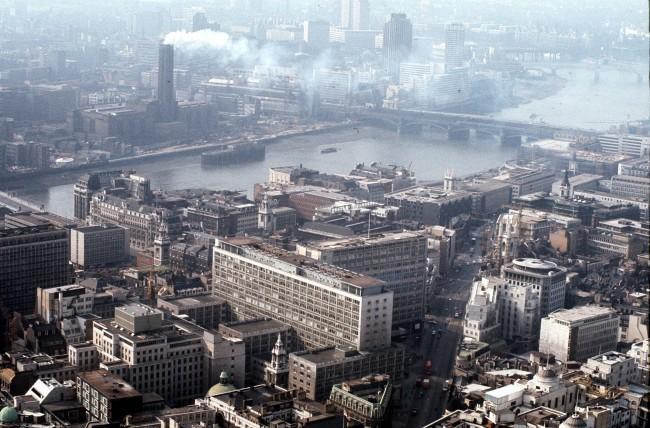
London as seen from the 600ft, 52-story Nat West Tower in the City. Bankside power station can be seen over the River Thames, belching out smoke from its chimney. Blackfriars Bridge is to the right. Date: 10/03/1977
Music – Wings – London
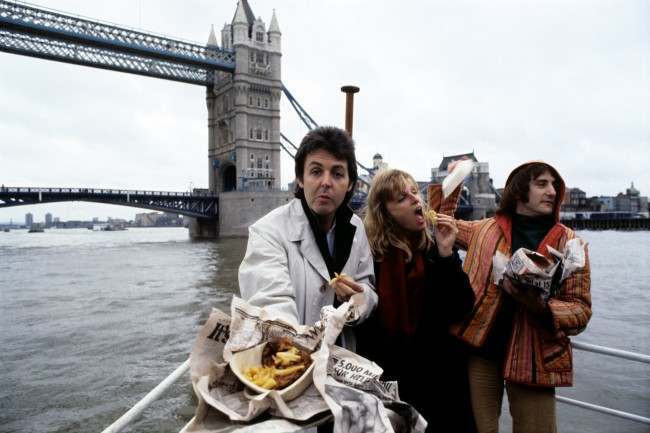
Members of the band Wings eating fish and chips on the river Thames. (l-r) Paul McCartney, Linda McCartney and Denny Laine. Date: 22/03/1978
Thames Barrier – Woolwich
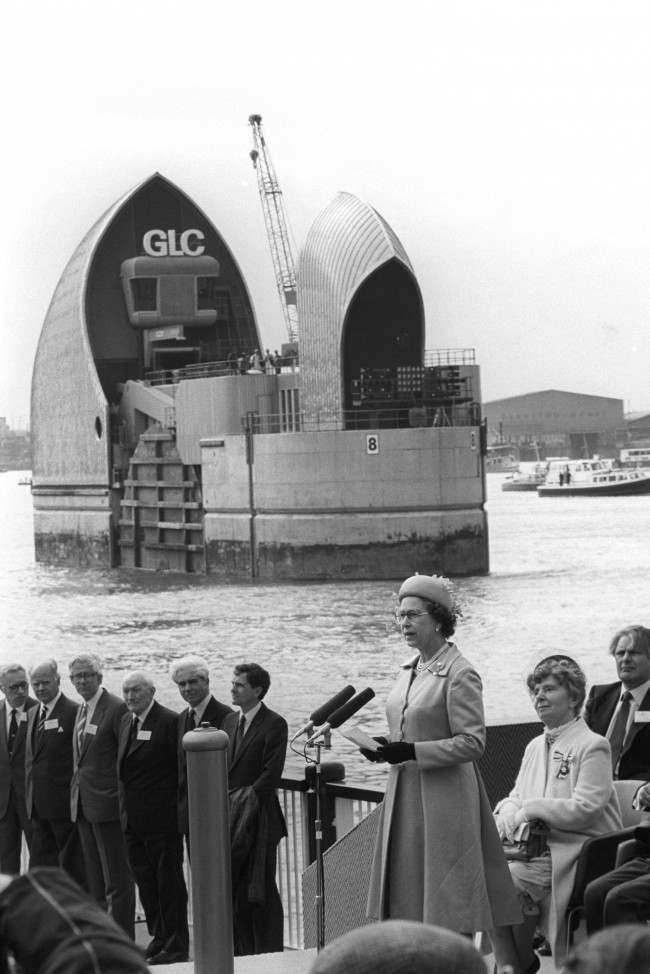
The Queen officially opening the £460 million Thames Barrier at Woolwich. Date: 08/05/1984
AIR London City Airport

Library filer of a Brymon Airways Dash 7 aircraft making history as it becomes the first airplane to land at the London City Airport. The loss-making airport, based in London’s Docklands, has been sold to Irish businessman Dermot Desmond for 14.5 million, it was announced. Date: 31/05/1987
Pleasure boat tragedy
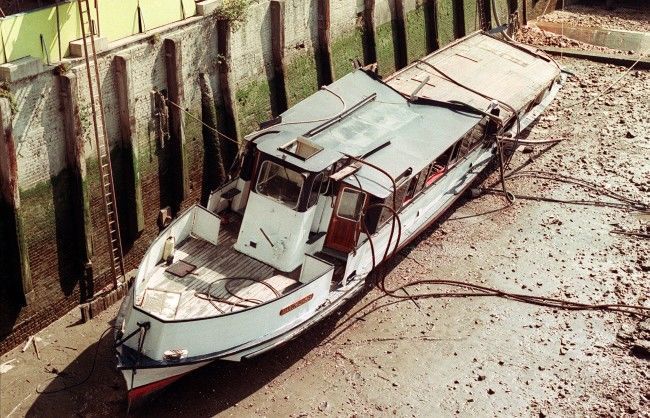
In 1989 the pleasure cruiser The Marchioness collided with a barge, The Bowbelle. The Thames pleasure cruiser the PV Marchioness which sank on the Thames near Southwark Bridge, London, has been taken to the north bank of the river for accident investigators to get to work on it. The boat sank while young people enjoyed a birthday party on board. Police have said that 57 people are known to have died in the disaster and 79 people survived it.
Canary Wharf Tower – London
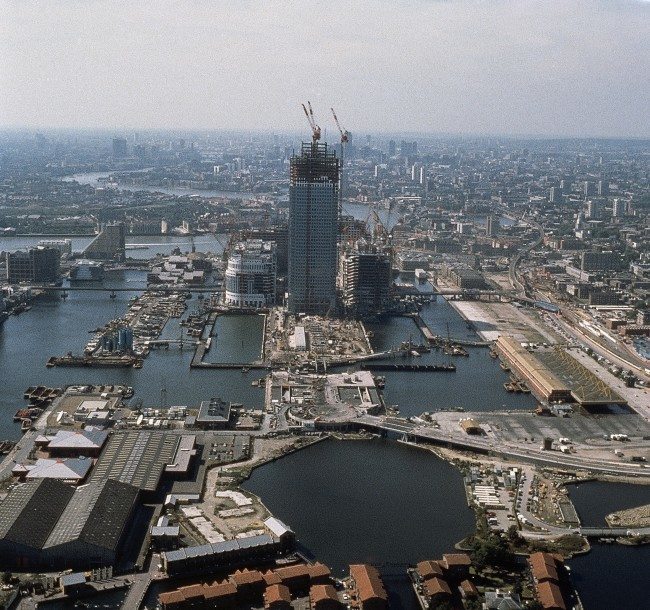
The 800ft Canary Wharf Tower under construction in London Docklands. The 50 storey towers steel structure contains 27,000 tonnes of British steel fastened by 500,000 bolts. Date: 06/11/1990
MILLENNIUM Gondolas 2

The gondolas which will hang from the London Eye make their journey by boat down the River Thames in Central London, passing the Millennium Dome and Canary Wharf, to the site of the giant wheel. The 32 capsules will take up to half an hour to travel round the wheel. * Weighing 1.5 tonnes and built in France by ski-lift company Poma will , and provide their passengers with views of up to 25 miles away. Date: 28/10/1999
2000
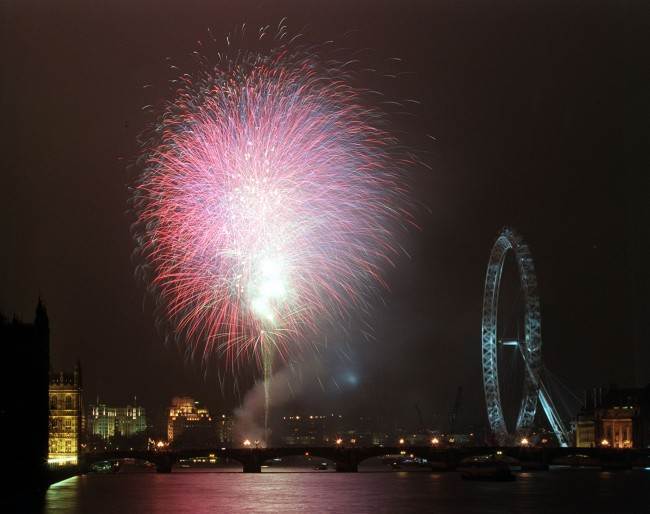
A firework explodes over the River Thames during the launch of the British Airways London Eye. However there were no passengers riding on the world’s largest ferris wheel after engineers discovered that a mechanism on one of the 32 pods was defective. Date: 31/12/1999
Would you like to support Flashbak?
Please consider making a donation to our site. We don't want to rely on ads to bring you the best of visual culture. You can also support us by signing up to our Mailing List. And you can also follow us on Facebook, Instagram and Twitter. For great art and culture delivered to your door, visit our shop.









